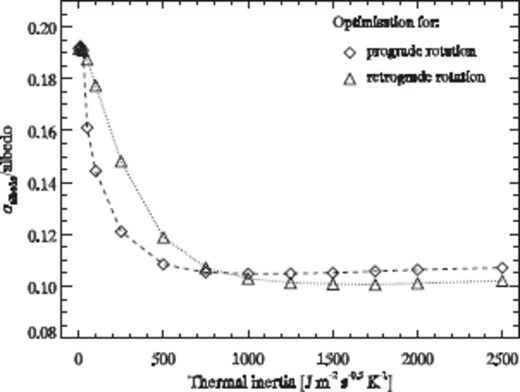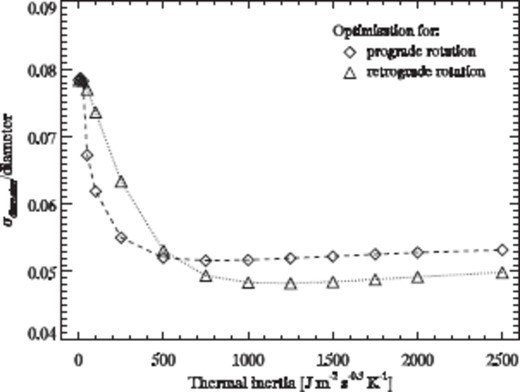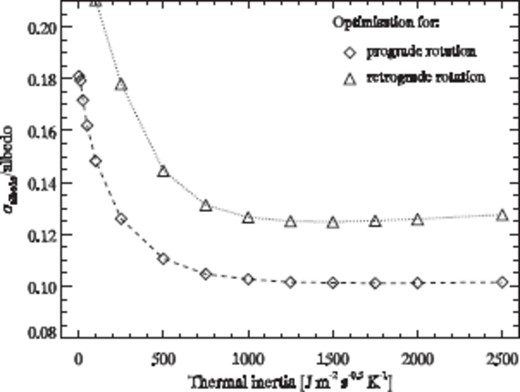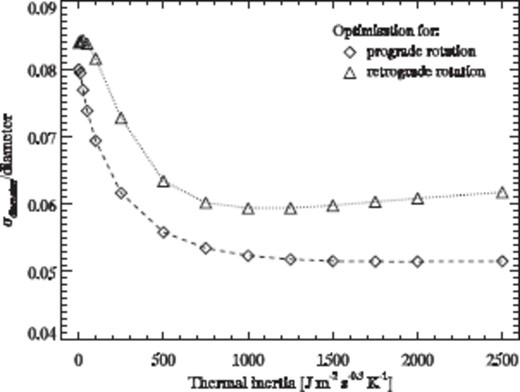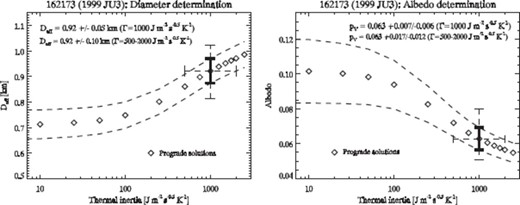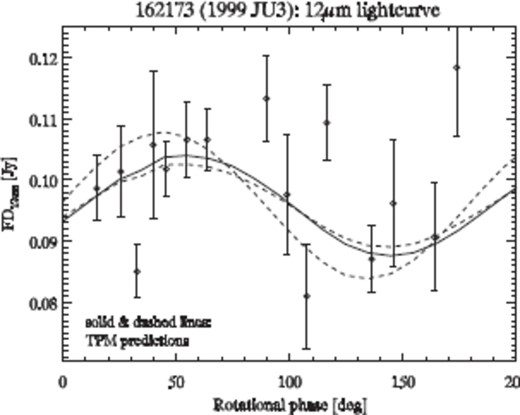-
PDF
- Split View
-
Views
-
Cite
Cite
Sunao Hasegawa, Thomas G. MüLler, Kyoko Kawakami, Toshihiro Kasuga, Takehiko Wada, Yoshifusa Ita, Naruhisa Takato, Hiroshi Terada, Takuya Fujiyoshi, Masanao Abe, Albedo, Size, and Surface Characteristics of Hayabusa-2 Sample-Return Target 162173 1999 JU3 from AKARI and Subaru Observations, Publications of the Astronomical Society of Japan, Volume 60, Issue sp2, 25 December 2008, Pages S399–S405, https://doi.org/10.1093/pasj/60.sp2.S399
Close - Share Icon Share
Abstract
Mid-infrared observations of the Apollo-type asteroid 162173 1999 JU3 were performed in 2007 May during its close Earth approach with the AKARI space telescope and in 2007 August with the Subaru telescope. A thermophysical model analysis of the obtained data resulted in a radiometric diameter of 0.92|$\pm$|0.12km and a visual geometric albedo of 0.063|$^{+0.020}_{-0.015}$|. The geometric albedo is typical for C-type asteroids. The solutions for the thermal inertia of 1999 JU3's surface material were not as clear as for the asteroid 25143 Itokawa due to less-favorable observing conditions. But the most likely solutions are connected to high thermal inertia values, indicating that the surface is predominantly covered by boulders and bare rocks, while areas with thick dust regolith are less common.
Introduction
The engineering spacecraft Hayabusa (former name: MUSES-C), which was launched by an MV-5 rocket on 2003 May 9, is a Japanese sample-return mission from a near-Earth asteroid Fujiwara et al.(2004). Hayabusa arrived at S-type asteroid 25143 Itokawa in 2005 September and made in-situ observations of Itokawa using onboard instruments for about three months. A lot of strange phenomena of the sub-km-sized asteroid were revealed by Hayabusa (Fujiwara et al.(2006)).
Following the Hayabusa mission, future asteroid missions are planned in Japan. S-type asteroids are distributed in large quantities in the inner part of the main-belt, but C-type asteroids are abundant in the middle and outer regions of the main-belt. C-type asteroids are known to be parent bodies of carbonaceous chondrites, having unaltered composition and more organic matter than other meteorites (e.g., Burbine et al.(2008)). Itokawa was classified as an S-type asteroid Binzel et al.(2001a). For these reasons, the target of a second asteroid sample-return probe, ``Hayabusa-2'', is planned to be a C-type asteroid Yoshikawa et al.(2008). Hayabusa-2 is expected to provide crucial information on these primitive bodies and, together with ground-based spectroscopic observations, will help give a big picture of the material distribution in the main belt.
The asteroid 162173 1999 JU3 (hereafter 1999 JU3) was discovered by LINEAR at Socorro on 1999 May 10. It is a near-Earth asteroid belonging to the Apollo group, which is defined as an asteroids having an orbital semi-major axis greater than 1AU and a perihelion distance smaller than 1.017AU. Visible reflectance spectra of 1999 JU3 were acquired by Binzel et al.(2001b) and Vilas (2008), who classified 1999 JU3 as a C-type asteroid. Binzel et al.(2004) indicated that 1999 JU3 is the second most accessible C-type asteroid for space probes. Taking mission scheduling for Hayabusa-2 into consideration, 1999 JU3 is the most accessible C-type asteroid Abe et al.(2007).
Knowledge about the physical properties of 1999 JU3 was limited to only spectral information Binzel et al.(2001b) before 2007. Thus, we must know other physical information, such as the rotation periods, shape, size, and albedo, to optimize the spacecraft design. Due to 1999 JU3's close approach to Earth in 2007, an observational campaign to investigate the nature of 1999 JU3 was conducted Abe et al.(2008).
There have been developed several techniques to measure the albedo and size of asteroids, but the radiometric method from thermal-radiation observations is a well-established and powerful method for estimating the albedos and diameters of asteroids. For instance, the size prediction of Itokawa using thermal observations is in almost perfect agreement with the final in-situ results Müller et al.(2007). The method can also distinguish between monolithic, regolith-covered and rubble pile asteroids. In order to investigate the albedo, size, and surface conditions of 1999 JU3, we carried out thermal infrared photometric observations with the AKARI (former name: ASTRO-F) infrared space telescope Murakami et al.(2007) and the Subaru telescope at Mauna Kea, Hawaii.
Here, we present the results of thermal infrared observations of 1999 JU3. Section 2 describes the observations and data-reduction procedures; section 3 shows the thermal modeling and results; section 4 discusses the results; and section 5 summarizes this study.
Observations and Data Reduction
AKARI/IRC Observations
Spacebased mid-infrared observations were performed on 2007 May 16 using the MIR-L channel on the infrared camera IRC Onaka et al.(2007) onboard AKARI. The Astronomical Observation Template (AOT) two-filter mode, IRC02 (see Onaka et al.(2007) for details) was used to observe the asteroid 1999 JU3. During one pointed observation, three IRC channels [near-infrared (NIR), shorter mid-infrared (MIR-S), and longer mid-infrared (MIR-L) channels] can operate simultaneously, covering different wavelength ranges. The NIR and MIR-S channels share the same field of view, while the MIR-L channel observes a region |$\sim$|20' away from the field centre of the NIR and MIR-S channels. Since the observations for 1999 JU3 were only carried out with one pointed observation, they were only obtained by the MIR-L channel. The MIR-L measurements were made in filters L15 (15.0µ) and L24 (24.0µ) with effective bandwidths of 6.2 and 5.4µ, respectively. The MIR-L channel of the IRC has pixel sizes of about 2.4"|$/$|pixel, giving a field of view of about 10'|$\times$|10'. Table 1 lists relevant observational circumstances and physical data for 1999 JU3.
Observational circumstances of asteroid 162173 1999 JU3.*
| No. . | Observation time . | Filter . | |$R_{\rm h}$| . | |$\mathit{\Delta}$| . | |$\alpha$| . | Remarks . |
|---|---|---|---|---|---|---|
| . | (UT) . | band . | (AU) . | (AU) . | (|$^\circ$|) . | . |
| 1 | 2007-05-16 00:51:26 | L15 | 1.414394 | 0.992030 | |$+$|45.63 | AKARI |
| 2 | 2007-05-16 00:53:32 | L24 | 1.414394 | 0.992019 | |$+$|45.63 | AKARI |
| 3 | 2007-08-28 11:13:55 | N11.7 | 1.287343 | 0.306801 | |$+$|22.30 | Subaru |
| 4 | 2007-08-28 11:27:26 | N12.4 | 1.287319 | 0.306769 | |$+$|22.30 | Subaru |
| 5 | 2007-08-28 11:36:29 | N10.5 | 1.287305 | 0.306751 | |$+$|22.30 | Subaru |
| 6 | 2007-08-28 11:45:34 | N9.7 | 1.287288 | 0.306728 | |$+$|22.29 | Subaru |
| 7 | 2007-08-28 11:52:48 | N11.7 | 1.287276 | 0.306712 | |$+$|22.29 | Subaru |
| 8 | 2007-08-28 12:04:29 | N8.8 | 1.287257 | 0.306687 | |$+$|22.29 | Subaru |
| 9 | 2007-08-28 12:15:50 | N11.7 | 1.287236 | 0.306660 | |$+$|22.29 | Subaru |
| 10 | 2007-08-28 12:48:58 | N11.7 | 1.287179 | 0.306586 | |$+$|22.28 | Subaru |
| 11 | 2007-08-28 13:00:29 | N12.4 | 1.287160 | 0.306561 | |$+$|22.28 | Subaru |
| 12 | 2007-08-28 13:11:33 | N8.8 | 1.287139 | 0.306535 | |$+$|22.28 | Subaru |
| 13 | 2007-08-28 13:22:48 | N11.7 | 1.287120 | 0.306510 | |$+$|22.28 | Subaru |
| 14 | 2007-08-28 13:48:00 | N11.7 | 1.287077 | 0.306455 | |$+$|22.27 | Subaru |
| 15 | 2007-08-28 14:00:03 | N12.4 | 1.287056 | 0.306429 | |$+$|22.27 | Subaru |
| 16 | 2007-08-28 14:23:00 | N8.8 | 1.287016 | 0.306379 | |$+$|22.27 | Subaru |
| 17 | 2007-08-28 14:35:31 | N11.7 | 1.286993 | 0.306350 | |$+$|22.26 | Subaru |
| No. . | Observation time . | Filter . | |$R_{\rm h}$| . | |$\mathit{\Delta}$| . | |$\alpha$| . | Remarks . |
|---|---|---|---|---|---|---|
| . | (UT) . | band . | (AU) . | (AU) . | (|$^\circ$|) . | . |
| 1 | 2007-05-16 00:51:26 | L15 | 1.414394 | 0.992030 | |$+$|45.63 | AKARI |
| 2 | 2007-05-16 00:53:32 | L24 | 1.414394 | 0.992019 | |$+$|45.63 | AKARI |
| 3 | 2007-08-28 11:13:55 | N11.7 | 1.287343 | 0.306801 | |$+$|22.30 | Subaru |
| 4 | 2007-08-28 11:27:26 | N12.4 | 1.287319 | 0.306769 | |$+$|22.30 | Subaru |
| 5 | 2007-08-28 11:36:29 | N10.5 | 1.287305 | 0.306751 | |$+$|22.30 | Subaru |
| 6 | 2007-08-28 11:45:34 | N9.7 | 1.287288 | 0.306728 | |$+$|22.29 | Subaru |
| 7 | 2007-08-28 11:52:48 | N11.7 | 1.287276 | 0.306712 | |$+$|22.29 | Subaru |
| 8 | 2007-08-28 12:04:29 | N8.8 | 1.287257 | 0.306687 | |$+$|22.29 | Subaru |
| 9 | 2007-08-28 12:15:50 | N11.7 | 1.287236 | 0.306660 | |$+$|22.29 | Subaru |
| 10 | 2007-08-28 12:48:58 | N11.7 | 1.287179 | 0.306586 | |$+$|22.28 | Subaru |
| 11 | 2007-08-28 13:00:29 | N12.4 | 1.287160 | 0.306561 | |$+$|22.28 | Subaru |
| 12 | 2007-08-28 13:11:33 | N8.8 | 1.287139 | 0.306535 | |$+$|22.28 | Subaru |
| 13 | 2007-08-28 13:22:48 | N11.7 | 1.287120 | 0.306510 | |$+$|22.28 | Subaru |
| 14 | 2007-08-28 13:48:00 | N11.7 | 1.287077 | 0.306455 | |$+$|22.27 | Subaru |
| 15 | 2007-08-28 14:00:03 | N12.4 | 1.287056 | 0.306429 | |$+$|22.27 | Subaru |
| 16 | 2007-08-28 14:23:00 | N8.8 | 1.287016 | 0.306379 | |$+$|22.27 | Subaru |
| 17 | 2007-08-28 14:35:31 | N11.7 | 1.286993 | 0.306350 | |$+$|22.26 | Subaru |
The heliocentric distance |$R_{\rm h}$|, the geocentric distance |$\mathit{\Delta}$|, and the phase angle |$\alpha$| for the asteroid 162173 1999 JU3 were obtained by the JPL Ephemeris Generator.|$^1$| The phase angles are positive before opposition and negative after.
Observational circumstances of asteroid 162173 1999 JU3.*
| No. . | Observation time . | Filter . | |$R_{\rm h}$| . | |$\mathit{\Delta}$| . | |$\alpha$| . | Remarks . |
|---|---|---|---|---|---|---|
| . | (UT) . | band . | (AU) . | (AU) . | (|$^\circ$|) . | . |
| 1 | 2007-05-16 00:51:26 | L15 | 1.414394 | 0.992030 | |$+$|45.63 | AKARI |
| 2 | 2007-05-16 00:53:32 | L24 | 1.414394 | 0.992019 | |$+$|45.63 | AKARI |
| 3 | 2007-08-28 11:13:55 | N11.7 | 1.287343 | 0.306801 | |$+$|22.30 | Subaru |
| 4 | 2007-08-28 11:27:26 | N12.4 | 1.287319 | 0.306769 | |$+$|22.30 | Subaru |
| 5 | 2007-08-28 11:36:29 | N10.5 | 1.287305 | 0.306751 | |$+$|22.30 | Subaru |
| 6 | 2007-08-28 11:45:34 | N9.7 | 1.287288 | 0.306728 | |$+$|22.29 | Subaru |
| 7 | 2007-08-28 11:52:48 | N11.7 | 1.287276 | 0.306712 | |$+$|22.29 | Subaru |
| 8 | 2007-08-28 12:04:29 | N8.8 | 1.287257 | 0.306687 | |$+$|22.29 | Subaru |
| 9 | 2007-08-28 12:15:50 | N11.7 | 1.287236 | 0.306660 | |$+$|22.29 | Subaru |
| 10 | 2007-08-28 12:48:58 | N11.7 | 1.287179 | 0.306586 | |$+$|22.28 | Subaru |
| 11 | 2007-08-28 13:00:29 | N12.4 | 1.287160 | 0.306561 | |$+$|22.28 | Subaru |
| 12 | 2007-08-28 13:11:33 | N8.8 | 1.287139 | 0.306535 | |$+$|22.28 | Subaru |
| 13 | 2007-08-28 13:22:48 | N11.7 | 1.287120 | 0.306510 | |$+$|22.28 | Subaru |
| 14 | 2007-08-28 13:48:00 | N11.7 | 1.287077 | 0.306455 | |$+$|22.27 | Subaru |
| 15 | 2007-08-28 14:00:03 | N12.4 | 1.287056 | 0.306429 | |$+$|22.27 | Subaru |
| 16 | 2007-08-28 14:23:00 | N8.8 | 1.287016 | 0.306379 | |$+$|22.27 | Subaru |
| 17 | 2007-08-28 14:35:31 | N11.7 | 1.286993 | 0.306350 | |$+$|22.26 | Subaru |
| No. . | Observation time . | Filter . | |$R_{\rm h}$| . | |$\mathit{\Delta}$| . | |$\alpha$| . | Remarks . |
|---|---|---|---|---|---|---|
| . | (UT) . | band . | (AU) . | (AU) . | (|$^\circ$|) . | . |
| 1 | 2007-05-16 00:51:26 | L15 | 1.414394 | 0.992030 | |$+$|45.63 | AKARI |
| 2 | 2007-05-16 00:53:32 | L24 | 1.414394 | 0.992019 | |$+$|45.63 | AKARI |
| 3 | 2007-08-28 11:13:55 | N11.7 | 1.287343 | 0.306801 | |$+$|22.30 | Subaru |
| 4 | 2007-08-28 11:27:26 | N12.4 | 1.287319 | 0.306769 | |$+$|22.30 | Subaru |
| 5 | 2007-08-28 11:36:29 | N10.5 | 1.287305 | 0.306751 | |$+$|22.30 | Subaru |
| 6 | 2007-08-28 11:45:34 | N9.7 | 1.287288 | 0.306728 | |$+$|22.29 | Subaru |
| 7 | 2007-08-28 11:52:48 | N11.7 | 1.287276 | 0.306712 | |$+$|22.29 | Subaru |
| 8 | 2007-08-28 12:04:29 | N8.8 | 1.287257 | 0.306687 | |$+$|22.29 | Subaru |
| 9 | 2007-08-28 12:15:50 | N11.7 | 1.287236 | 0.306660 | |$+$|22.29 | Subaru |
| 10 | 2007-08-28 12:48:58 | N11.7 | 1.287179 | 0.306586 | |$+$|22.28 | Subaru |
| 11 | 2007-08-28 13:00:29 | N12.4 | 1.287160 | 0.306561 | |$+$|22.28 | Subaru |
| 12 | 2007-08-28 13:11:33 | N8.8 | 1.287139 | 0.306535 | |$+$|22.28 | Subaru |
| 13 | 2007-08-28 13:22:48 | N11.7 | 1.287120 | 0.306510 | |$+$|22.28 | Subaru |
| 14 | 2007-08-28 13:48:00 | N11.7 | 1.287077 | 0.306455 | |$+$|22.27 | Subaru |
| 15 | 2007-08-28 14:00:03 | N12.4 | 1.287056 | 0.306429 | |$+$|22.27 | Subaru |
| 16 | 2007-08-28 14:23:00 | N8.8 | 1.287016 | 0.306379 | |$+$|22.27 | Subaru |
| 17 | 2007-08-28 14:35:31 | N11.7 | 1.286993 | 0.306350 | |$+$|22.26 | Subaru |
The heliocentric distance |$R_{\rm h}$|, the geocentric distance |$\mathit{\Delta}$|, and the phase angle |$\alpha$| for the asteroid 162173 1999 JU3 were obtained by the JPL Ephemeris Generator.|$^1$| The phase angles are positive before opposition and negative after.
Raw data were processed with the IRC imaging data pipeline (see AKARI IRC Data Users Manual ver. 1.32 for details). The AKARI telescope was not able to track moving objects, such as comets and asteroids. Therefore, a centroid determination in combination with a standard shift-and-add technique was performed before median processing was necessary, so as to avoid compromising the photometric accuracy. Aperture photometry for 1999 JU3 on MIR-L images was performed using the APPHOT task of IRAF with a circular aperture radius of 7.5pixels; the same aperture radius had been used in the standard star flux calibration. Uncalibrated instrument magnitudes were converted to the calibrated flux densities by using the IRC flux calibration constants in revisions of the IRC conversion factors.|$^2$| Colour differences between the calibration stars and 1999 JU3 were not negligible, owing to the wide bandwidth of MIR-L. Colour correction factors were obtained using both the predicted thermal flux and the relative spectral response functions for L15 and L24. Colour correction fluxes of 1999 JU3 were taken by dividing the quoted fluxes by 0.967 in the L18 band and 1.062 in the L24 band. The resulting fluxes of 1999 JU3 are listed in table 2.
Summary of observed fluxes for asteroid 162173 1999 JU3.
| No. . | Filter . | |$\lambda_{\rm c}$| . | Flux . | Error . | Remarks . |
|---|---|---|---|---|---|
| . | band . | (|$\mu$|m) . | (mJy) . | (mJy) . | . |
| 1 | L15 | 15.0 | 8.16 | 0.42 | AKARI |
| 2 | L24 | 24.0 | 7.31 | 0.61 | AKARI |
| 3 | N11.7 | 11.7 | 95.62 | 10.24 | Subaru |
| 4 | N12.4 | 12.4 | 105.12 | 15.33 | Subaru |
| 5 | N10.5 | 10.5 | 70.07 | 7.19 | Subaru |
| 6 | N9.7 | 9.7 | 75.47 | 17.20 | Subaru |
| 7 | N11.7 | 11.7 | 98.72 | 8.58 | Subaru |
| 8 | N8.8 | 8.8 | 61.50 | 7.03 | Subaru |
| 9 | N11.7 | 11.7 | 103.41 | 9.81 | Subaru |
| 10 | N11.7 | 11.7 | 110.07 | 13.48 | Subaru |
| 11 | N12.4 | 12.4 | 100.98 | 20.43 | Subaru |
| 12 | N8.8 | 8.8 | 47.90 | 10.19 | Subaru |
| 13 | N11.7 | 11.7 | 106.23 | 11.94 | Subaru |
| 14 | N11.7 | 11.7 | 84.56 | 10.58 | Subaru |
| 15 | N12.4 | 12.4 | 99.62 | 21.47 | Subaru |
| 16 | N8.8 | 8.8 | 52.24 | 10.21 | Subaru |
| 17 | N11.7 | 11.7 | 114.79 | 21.85 | Subaru |
| No. . | Filter . | |$\lambda_{\rm c}$| . | Flux . | Error . | Remarks . |
|---|---|---|---|---|---|
| . | band . | (|$\mu$|m) . | (mJy) . | (mJy) . | . |
| 1 | L15 | 15.0 | 8.16 | 0.42 | AKARI |
| 2 | L24 | 24.0 | 7.31 | 0.61 | AKARI |
| 3 | N11.7 | 11.7 | 95.62 | 10.24 | Subaru |
| 4 | N12.4 | 12.4 | 105.12 | 15.33 | Subaru |
| 5 | N10.5 | 10.5 | 70.07 | 7.19 | Subaru |
| 6 | N9.7 | 9.7 | 75.47 | 17.20 | Subaru |
| 7 | N11.7 | 11.7 | 98.72 | 8.58 | Subaru |
| 8 | N8.8 | 8.8 | 61.50 | 7.03 | Subaru |
| 9 | N11.7 | 11.7 | 103.41 | 9.81 | Subaru |
| 10 | N11.7 | 11.7 | 110.07 | 13.48 | Subaru |
| 11 | N12.4 | 12.4 | 100.98 | 20.43 | Subaru |
| 12 | N8.8 | 8.8 | 47.90 | 10.19 | Subaru |
| 13 | N11.7 | 11.7 | 106.23 | 11.94 | Subaru |
| 14 | N11.7 | 11.7 | 84.56 | 10.58 | Subaru |
| 15 | N12.4 | 12.4 | 99.62 | 21.47 | Subaru |
| 16 | N8.8 | 8.8 | 52.24 | 10.21 | Subaru |
| 17 | N11.7 | 11.7 | 114.79 | 21.85 | Subaru |
Summary of observed fluxes for asteroid 162173 1999 JU3.
| No. . | Filter . | |$\lambda_{\rm c}$| . | Flux . | Error . | Remarks . |
|---|---|---|---|---|---|
| . | band . | (|$\mu$|m) . | (mJy) . | (mJy) . | . |
| 1 | L15 | 15.0 | 8.16 | 0.42 | AKARI |
| 2 | L24 | 24.0 | 7.31 | 0.61 | AKARI |
| 3 | N11.7 | 11.7 | 95.62 | 10.24 | Subaru |
| 4 | N12.4 | 12.4 | 105.12 | 15.33 | Subaru |
| 5 | N10.5 | 10.5 | 70.07 | 7.19 | Subaru |
| 6 | N9.7 | 9.7 | 75.47 | 17.20 | Subaru |
| 7 | N11.7 | 11.7 | 98.72 | 8.58 | Subaru |
| 8 | N8.8 | 8.8 | 61.50 | 7.03 | Subaru |
| 9 | N11.7 | 11.7 | 103.41 | 9.81 | Subaru |
| 10 | N11.7 | 11.7 | 110.07 | 13.48 | Subaru |
| 11 | N12.4 | 12.4 | 100.98 | 20.43 | Subaru |
| 12 | N8.8 | 8.8 | 47.90 | 10.19 | Subaru |
| 13 | N11.7 | 11.7 | 106.23 | 11.94 | Subaru |
| 14 | N11.7 | 11.7 | 84.56 | 10.58 | Subaru |
| 15 | N12.4 | 12.4 | 99.62 | 21.47 | Subaru |
| 16 | N8.8 | 8.8 | 52.24 | 10.21 | Subaru |
| 17 | N11.7 | 11.7 | 114.79 | 21.85 | Subaru |
| No. . | Filter . | |$\lambda_{\rm c}$| . | Flux . | Error . | Remarks . |
|---|---|---|---|---|---|
| . | band . | (|$\mu$|m) . | (mJy) . | (mJy) . | . |
| 1 | L15 | 15.0 | 8.16 | 0.42 | AKARI |
| 2 | L24 | 24.0 | 7.31 | 0.61 | AKARI |
| 3 | N11.7 | 11.7 | 95.62 | 10.24 | Subaru |
| 4 | N12.4 | 12.4 | 105.12 | 15.33 | Subaru |
| 5 | N10.5 | 10.5 | 70.07 | 7.19 | Subaru |
| 6 | N9.7 | 9.7 | 75.47 | 17.20 | Subaru |
| 7 | N11.7 | 11.7 | 98.72 | 8.58 | Subaru |
| 8 | N8.8 | 8.8 | 61.50 | 7.03 | Subaru |
| 9 | N11.7 | 11.7 | 103.41 | 9.81 | Subaru |
| 10 | N11.7 | 11.7 | 110.07 | 13.48 | Subaru |
| 11 | N12.4 | 12.4 | 100.98 | 20.43 | Subaru |
| 12 | N8.8 | 8.8 | 47.90 | 10.19 | Subaru |
| 13 | N11.7 | 11.7 | 106.23 | 11.94 | Subaru |
| 14 | N11.7 | 11.7 | 84.56 | 10.58 | Subaru |
| 15 | N12.4 | 12.4 | 99.62 | 21.47 | Subaru |
| 16 | N8.8 | 8.8 | 52.24 | 10.21 | Subaru |
| 17 | N11.7 | 11.7 | 114.79 | 21.85 | Subaru |
Subaru/COMICS Observations
Groundbased mid-infrared observations were taken on August 28, 2007 using the COMICS Kataza et al.(2000) instrument, installed at the Cassegrain focus of the Subaru 8.2-m telescope. A Si:As IBC detector having a format of 320|$\times$|240 was used with an imaging scale of 0.13". The field of view of COMICS was 42"|$\times$|32". |$N$|-band filters centered on 8.8, 9.7, 10.5, 11.7, and 12.4 with effective bandwidths of 0.8, 0.9, 1.0, 1.0, and 1.0µ were used. The Subaru telescope was tracked at the rates predicted from the ephemerids of the asteroid 1999 JU3. To reduce the atmospheric and telescopic background radiation, a standard chopping and nodding method was utilized. Chop and nod throws were 7", respectively. Typical exposure times for standard stars and 1999 JU3 were 10 and 100s, respectively. Table 1 summarizes relevant observational circumstances and physical data for 1999 JU3.
An absolute calibration star near on the sky to 1999 JU3 was chosen. The calibration star, 66 Peg (HD220363), was taken from a template of Cohen et al.(1999). Observations of 66 Peg were done at similar airmasses and times to the 1999 JU3 observations as much as possible. The spectral energy distributions of 66 Peg were combined with the relative spectral response functions of COMICS, including the atmospheric transmission and fluxes of 66 Peg, which were obtained for each band center. Measurements of 1999 JU3 and 66 Peg were made through a circular aperture with a diameter of three-times the seeing size using the APPOT task of IRAF. The absolute fluxes for 1999 JU3 were obtained by multiplying the absolute fluxes of 66 Peg by the ratio of the 1999 JU3 counts with the 66 Peg counts, in each filter. The color difference between the spectral energy distributions of 1999 JU3 and 66 Peg in the COMICS filter were found to be about a few percent. Thus, color corrections for COMICS observations were not applied. The obtained fluxes for 1999 JU3 are given in table 2.
Thermophysical Model Analysis and Results
The thermophysical model (TPM) was developed by Lagerros (1996, 1997, 1998) and refined by Müller and Lagerros (1998, 2002). It was applied to investigate the physical and thermal properties of the asteroid 1999 JU3. The TPM includes various physical characteristics as model parameters, such as the rotational period (|$P_{\rm sid}$|), the global shape (typically ellipsoidal shape models with the semi-major axis ratios |$a/b$| and |$b/c$|, but also more sophisticated shape models are possible), spin vector, thermal inertia |$\mathit{\Gamma}$|, the r.m.s. of surface slopes |$\rho$|, and the fraction of the surface covered by craters |$f$|. Thus, the TPM is more accurate than simple thermal models, such as the standard thermal model Lebofsky et al.(1986), the isothermal latitude model Veeder et al.(1989), or the near-Earth asteroid thermal model Harris (1998).
The thermal behavior of an asteroid is strongly influenced by the thermal inertia, the asteroid's rotation period, and the direction of the spin vector. Especially, the thermal inertia is an important parameter for observations obtained in the case of very large phase angles where the non-illuminated part of the surface can contribute significantly to the observed disk-integrated flux. Our measurements from AKARI and Subaru were obtained at different phase angles, heliocentric distances, and wavelengths, and the thermal inertia influence is different for these different configurations (e.g., Müller(2002)). Therefore, we considered for our thermophysical analysis the full physically meaningful range from 0 to 2500Jm|$^{-2}$|s|$^{-0.5}$|K|$^{-1}$|.
As a first step, we tried to find the optimum thermal inertia for 1999 JU3 that would make the individual radiometric diameters and albedo solutions most consistent, i.e., we were looking for the minimum in the (|$\sigma_{\rm albedo}$|)|$/$|albedo and (|$\sigma_{\rm diameter}$|)|$/$|diameter calculations, while varying the thermal inertia (figures 1-4). This procedure follows to a large extent the method successfully used for the thermal inertia calculation for the asteroid 25143 Itokawa by Müller et al.(2005). Müller(2002) and Müller et al.(2005) pointed out that variations in the beaming parameters, |$\rho$| and |$f$|, are only of secondary influence in this optimization process, and that very extreme values for |$\rho$| and |$f$| are very unlikely. Therefore, the default beaming values, |$\rho$||$=$| 0.7 and |$f$||$=$| 0.6, were used to model 1999 JU3. A constant, wavelength-independent emissivity value of 0.9 was accepted. The absolute magnitude of |$H_{v}$| and the slope parameter, |$G$|, were taken from K. Kawakami et al. (2008, private communication) with |$H_{v}$||$=$| 18.81|$\pm$|0.03 and |$G$||$=$||$-$|0.115|$\pm$|0.009.
As a shape model for 1999 JU3, we first used a spherical body with it's spin vector perpendicular to the ecliptic plane and a prograde rotation with 7h37min38s (K. Kawakami et al., 2008, private communication). The results are shown in figures 1 and 2.
Thermal inertia optimisation process for individual thermophysical model albedo and their standard deviation for the sphere shape.
Thermal inertia optimisation process for individual thermophysical model diameters and their standard deviations for the sphere shape.
Figures 1 and 2 show the effect on basis of the (|$\sigma_{\rm albedo}$|)|$/$|albedo and (|$\sigma_{\rm diameter}$|)|$/$|diameter values in the case of a spherical shape, respectively. The thermal inertia |$\mathit{\Gamma}$||$\gtrsim$| 500Jm|$^{-2}$|s|$^{-0.5}$|K|$^{-1}$| solution seems to give the most reliable result. The retrograde solutions seem to be better than those for prograde rotation, but this is not consistent with the currently favored solution (K. Kawakami et al., 2008, private communication).
As a second step, an ellipsoidal shape was adopted instead of a sphere. On the basis of the lightcurve variation of |$\pm$|0.1 (K. Kawakami et al., 2008, private communication), an ellipsoidal shape with |$a/b$||$=$| 1.21 and |$b$||$=$||$c$| was presumed. This would correspond roughly to |$H_{v}$||$=$| 18.92mag at the lightcurve minimum and |$H_{v}$||$=$| 18.71mag at the lightcurve maximum (for visual geometric albedo |$p_{\rm V}$||$=$| 0.068 and under the assumption that we would see the rotating ellipsoid edge-on). The infrared data obtained by Subaru-COMICS were ``transported'' to 12.0µ via TPM calculations, allowing the construction of a thermal lightcurve with absolute timing. The synchronisation of the model with the observed lightcurve required absolute times and rotational phases to the ellipsoidal body (with 90|$^{\circ}$| ecliptic latitude of the spin axis direction). We defined a zero phase of 0.0D at an arbitrary zero time of JD2454319.98 and optimized the ecliptic longitude of the spin axis direction to match the observations. We found that the best solution for the coordinates of the spin vector of 1999 JU3 must be around |$\lambda$||$=$| 125|$^{\circ}\pm$|10|$^{\circ}$| (in combination with |$\beta$||$=$||$+$|90|$^{\circ}$|).
With the ellipsoidal shape, the optimisation process for the thermal inertia of 1999 JU3 was repeated. Figures 3 and 4 show the effect on the basis of the (|$\sigma_{\rm albedo}$|)|$/$|albedo and (|$\sigma_{\rm diameter}$|)|$/$|diameter values in the case of the ellipsoidal shape, respectively. The (|$\sigma_{\rm albedo}$|)|$/$|albedo and (|$\sigma_{\rm diameter}$|)|$/$|diameter values are slightly better for the ellipsoidal shape compared to the spherical shape. The thermal inertia is likely to be higher than |$\gtrsim$|500Jm|$^{-2}$|s|$^{-0.5}$|K|$^{-1}$|, but there is no clean solution, as was the case for Itokawa, due to the less favorable observing geometries for 1999 JU3. We take as an optimum solution a value of 1000Jm|$^{-2}$|s|$^{-0.5}$|K|$^{-1}$|. Now, however, the prograde rotation result is favored, in agreement with a report about the rotation direction by K. Kawakami et al. (2008, private communication).
Thermal inertia optimization process for individual thermophysical model albedos and their standard deviations for the ellipsoidal shape.
Thermal inertia optimization process for individual thermophysical model diameters and their standard deviations for the ellipsoidal shape.
The value of the thermal inertia is important to thermophysical model analysis. As can be seen in figures 3 and 4, the best fit suggests a high thermal inertia of more than 500Jm|$^{-2}$|s|$^{-0.5}$|K|$^{-1}$|. Figure 5 shows the overall diameter and albedo values as a function of the thermal inertia (for the favored prograde rotation). In the case of high thermal inertia, the scatter of the fluxes is much smaller than those for low thermal inertia.
Using the |$\mathit{\Gamma}$||$=$| 500-2500Jm|$^{-2}$|s|$^{-0.5}$|K|$^{-1}$| solution in combination with the specified ellipsoidal shape and a prograde rotation, the weighted mean values (and standard deviations) are: 0.92|$\pm$|0.10km for the effective diameter [|$D_{\rm eff}$||$=$| 2(|$abc$|)|$^{1/3}$|] and 0.063|$^{+0.017}_{-0.012}$| for the visual geometric albedo of 1999 JU3. Including in addition to the uncertainties of the |$H$|-magnitude, the surface roughness influences, we estimated total errors of |$\pm$|0.12km for the effective diameter and |$^{+0.020}_{-0.015}$| for the geometric albedo. The overall dimension of our assumed ellip-soidal shape model is therefore 1.05|$\times$|0.86|$\times$|0.86 (|$\pm$|0.17)km.
Using these values as defaults in the TPM we can also ``transport'' all observations to a fictive wavelength of 12.0µ in order to establish a thermal lightcurve. Figure 6 shows these ``transported'' values as a function of the rotational phase. The corresponding thermal lightcurve is shown as a solid line. The dashed lines represent TPM solutions with significantly smaller and larger thermal inertias. Based on this figure it is not possible to eliminate the possibilities of smaller or higher thermal inertia, as it was the case for Itokawa. A clean full TPM solution can only be found if more thermal data would be available, preferentially after opposition with negative phase angles and/or including larger phase angles.
Overall diameter and albedo solutions as a function of the thermal inertia assuming a prograde ellipsoidal shape model. The dashed lines reflect only the observational uncertainties.
Predicted thermal lightcurve at 12.0|$\,\mu$|m for the observed rotational phases. The original measurements were ``transported'' to the 12.0|$\,\mu$|m wavelength via our best TPM solution. Predictions and measurements are shown with their absolute values; no shifting or scaling in time or flux has been done. Variations in the thermal inertia have only a small influence on the lightcurve amplitude and the rotational phase for the given 22|$^{\circ}$| phase angle constellation.
Discussion
We have determined the radiometric size and albedo and a likely value for the thermal inertia for the asteroid 1999 JU3. The geometric albedo of 1999 JU3 is compatible with the mean value of the geometric albedo for a C-type asteroid, 0.07|$\pm$|0.05, based on results from the Infrared Astronomical Satellite Tedesco et al.(2002a), the Mid-course Space Experiment Tedesco et al.(2002b), the Infrared Space Observatory Tedesco & Desert(2002), and groundbased observations (Hansen (1976),Cruikshank & Jones (1977); Lebofsky et al. 1978, 1981; Brown & Morrison(1984),Green et al.(1985),Vilas et al.(1985),Veeder et al.(1989),Campins et al.(1995),Mottola et al. (1997),Harris (1998),Harris et al.(1998),Harris & Davies (1999),Fernández et al.(2005),Harris et al.(2005)). The size of 1999 JU3 is significantly larger than that of the asteroid 25143 Itokawa.
The value of thermal inertia is important for thermophysical model analysis. As can be seen in figures 3 and 4, the best fit suggests a high thermal inertia of more than 500Jm|$^{-2}$|s|$^{-0.5}$|K|$^{-1}$|. In the case of high thermal inertia, the scatter of fluxed data is much smaller than those for low thermal inertia. Figure 5 shows the diameter and albedo solutions as a function of the thermal inertia.
All observations in this study were taken before opposition (see table 1), which means that a warm terminator for prograde rotators is seen. Without any observations after opposition, it is difficult to obtain a clean minimum solution for the thermal inertia in the diameter/albedo optimization process. It would be necessary to obtain new observations either after opposition or at different rotational phases and/or wavelengths to find better solutions for the thermal inertia.
According to Müller and Lagerros(1998), typical thermal inertia of large asteroids range between 5 and 25Jm|$^{-2}$|s|$^{-0.5}$|K|$^{-1}$|. In contrast, sub-km sized asteroids seem to have thermal inertias ranging from 100 to 1000Jm|$^{-2}$|s|$^{-0.5}$|K|$^{-1}$| (e.g., Müller et al. 2004, 2005; Harris et al.(2007),Delbo et al.(2007)). Our value is consistent with the thermal inertia of sub-km sized asteroids.
The surface properties on sub-km sized asteroids were predicted by theoretical estimates Michikami(2001) and extrapolations using observations Hasegawa & Abe(2001); they predicted that sub-km sized asteroids have less than 1-mm thickness regolith, and that the surface is covered by sub-meter- and meter-sized particles, respectively. However, the surface condition of sub-km sized asteroids was not directly observed before Hayabusa exploration. Hayabusa discovered numerous boulders on the surface of the asteroid 25143 Itokawa, and confirmed that there exist small-sized asteroids without fine-particle regolith for the first time Fujiwara et al.(2006). In comparing Hayabusa images with analysis from the thermophysical model, Müller et al.(2007) pointed out that a high thermal inertia is an indication of boulders and bare rocks on the surface, and that a thick dust regolith can be excluded. Therefore, our results from the modeling procedure almost certainly exclude a body with a thick dust regolith on the surface, but it remains unclear if 1999 JU3 is a rubble pile (with intermediate thermal inertia values in the range 500-1500) or if it has a solid rock surface (very high thermal inertia above 2000).
Conclusions
A thermophysical model was applied to mid-infrared photometric observations of the Apollo-type asteroid 162173 1999 JU3 using the IRC camera onboard the AKARI space telescope and the COMICS instrument mounted on the Subaru telescope. The analysis resulted in an effective diameter of 0.92|$\pm$|0.12km and a visual geometric albedo of 0.063|$^{+0.020}_{-0.015}$|. The low albedo is compatible with a C-type taxonomic-type classification. Based on the small dataset of visual and infrared data, also limited in aspect angles, we found the best match between TPM predictions and the available thermal observations under the assumption of a rotating ellipsoid with 1.05|$\times$|0.86|$\times$|0.86 (|$\pm$|0.17)km in size (based on the minimum ellipsoidal axis ratio explaining the visual lightcurves and assuming a prograde rotation with a spin vector perpendicular to the ecliptic plane). The model also shows that the thermal inertia of the surface material of 1999 JU3 is likely to be above 500Jm|$^{-2}$|s|$^{-0.5}$|K|$^{-1}$|. This result would indicate a surface dominated by boulders and bare rocks.
The Hayabusa mission determined many properties of Itokawa. Hayabusa-2 is also expected to continue the work begun by Hayabusa. Our work is critical for the spacecraft design and mission planning of Hayabusa-2, and will further contribute to surface exploration techniques using thermal infrared ``remote sensing'' observations in combination with thermophysical models.
We would like to thank Dr. S. D. Wolters for his comments and suggestions, which improved the paper significantly. We would like to express our gratitude to the staff members of AKARI and the Subaru Observatory for their support of observations. This work was partially supported by the Japan Society for the Promotion of Science, under the Grant-in-Aid for Scientific Research (B) 17340133. T. Kasuga was supported by JSPS Research fellowship for young scientists. S. Hasegawa was supported by Space Plasma Laboratory, ISAS, JAXA. 1999JU3 observations by AKARI and Subaru were executed as director's time observations.
References
Partly based on observations obtained with AKARI, a JAXA project with the participation of ESA.
Based in part on data collected at Subaru Telescope, which is operated by the National Astronomical Observatory of Japan.
AKARI IRC Data Users Manual |$\langle$|http://www.ir.isas.jaxa.jp/ASTRO-FObservation/DataReduction/IRC/ConversionFactor_071220.html|$\rangle$|.



